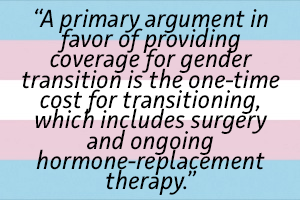Sex Reassignment Surgery For Transgenders: Should It Be Covered By Health Insurance?
September 9, 2016

What makes transitioning genders so financially draining? Studies on this issue have identified discrimination and lack of health insurance to be the two primary obstacles.
- Discrimination. Transgender people often have trouble finding health care providers that are trained in and respectful of their concerns. Their self-identity may also resulting more difficulty finding high-paying jobs despite their skill set, since their concerns are unique and very few companies have the resources to address them properly.
- Lack of Insurance Coverage. Health insurance companies are reluctant to foot the costs of transitioning, which has many phases, such as hormone therapy to actual gender reassignment surgery. As it is not a quick process, the cost of changing gender can be prohibitive for insurance companies as well as the insured. This makes such a process less common than it might otherwise be for some people.

Should insurance companies consider covering gender re-assignment? Johns Hopkins University Bloomberg’s School of Public Health and UCLA’s William’s Institute of Law has examined this issue, and offer data that might make insurers consider the financial benefits of expanded coverage, which will also be beneficial to those undergoing such reassignment.
The study, published in the Journal of General Internal Medicine, explored the cost-effectiveness of transgender health-care coverage for insurance companies, especially when compared with long-term treatments such as chronic ailments for which there are no cures. Lead author William Padula has pointed out significant arguments in favor of covering transition.

The survey, conducted by the Williams Institute, focused on employers that provided transition-related health care coverage to its employees. Results suggest that it is in favor for both employees and employers without any significant financial impact on the company.
- Low costs. According to the survey, two-thirds of employer-participants reported there is no additional cost in providing this additional coverage for their employees.
- Few claims. If an employee claims any transition-related health care benefits, it might financially impact their employer. The survey grouped the participants according to the number of employees and the claims the latter has made for transitioning. According to them, it’s just 0.054 claimants per 1,000
- Limited options. Despite this, most of these employer-covered transition treatments have restrictions which limit the options of transgender people from accessing it. Only 59 percent of the participants cover surgical procedures and 48 percent limit their coverage within the United States.
There is hope for transgender transition. Medicare and Medicaid services have begun paying for sexual reassignment 
Some U.S. companies have initiated inclusion of these benefits for their employees. This change has resulted in a rise in sexual-reassignment surgeries paid by insurance. This may be a financial advantage for those who are looking forward to transitioning, but with increased access due to affordability, the previous six-month wait may extend to a year or more as more and more patients get in line to externally display their internal gender identity.
The transgender population is small, but has become much more visible in recent years in political, medical, social and civil areas of life. Gender transition has been a high hill to climb for many transgender people due to the prohibitive cash cost. However, the Williams Institute survey gives new hope to transgender people individually, but also sheds light on the benefits of offering transgender care in health-insurance plans. As a result, employers are embracing very low costs in adding the coverage to their group plans while seeing a dramatic increase in social consciousness and promoting diversity and equality in their workforces. In a cost-benefit analysis, providing gender-reassignment coverage seems to only be a positive net effect across the board.
Reference:
- Leal, S. (2015). I Can’t Afford to Transition: The Unseen Costs of Being Transgender in 2015. Marie Claire. Retrieved 18 August 2016, from http://www.marieclaire.com/culture/news/a15164/transgender-operation-procedure-costs/
- Desmon, S. (2015). Insurance for sex reassignments is cost effective – Futurity. Futurity. Retrieved 18 August 2016, from http://www.futurity.org/transgender-insurance-1063212-2/
- Epic Week For Transgender Rights Expands With Health Care Protections — ThinkProgress. (2016). Medium. Retrieved 18 August 2016, from https://thinkprogress.org/epic-week-for-transgender-rights-expands-with-health-care-protections-e355d3d51d6b#.axwrtsofo
- Green, J. & Tracer, Z. (2016). Sex Reassignment Is Latest Company Benefit in Equality Push – Bloomberg. Bloomberg.com. Retrieved 18 August 2016, from http://www.bloomberg.com/news/articles/2015-09-21/sex-reassignment-is-latest-company-benefit-in-push-for-equality
- Herman, PhD, J. (2013). Costs and Benefits of Providing Transition-Related Health Care Coverage In Employee Health Benefits Plans. Williams Institute Law (UCLA). Retrieved 18 August 2016, from http://williamsinstitute.law.ucla.edu/wp-content/uploads/Herman-Cost-Benefit-of-Trans-Health-Benefits-Sept-2013.pdf’
Author Bio








